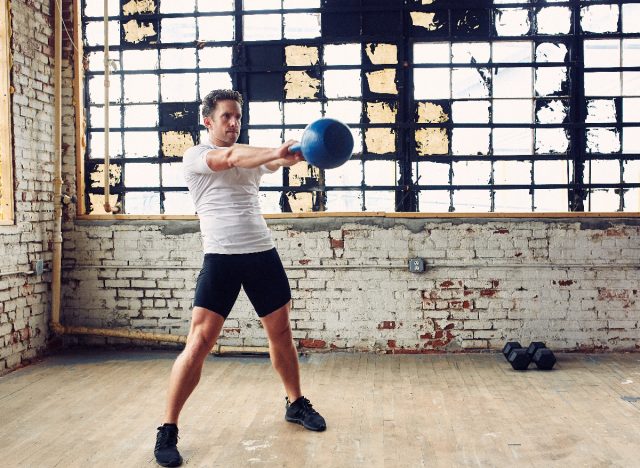The Deadlift Alternative That Works Your Whole Body at Home

In today’s world, having reliable at-home workout options isn’t just convenient; it’s practically essential. Whether you’re working around a busy schedule, traveling, or simply don’t have access to a gym, the ability to train effectively at home can be the difference between falling off track and staying consistent with your fitness goals. But while bodyweight workouts can cover a lot of ground, they often fall short when replicating the big, foundational lifts, especially the deadlift.
Let’s be honest: few home gyms have a barbell, bumper plates, and the floor space to pull heavy. And yet, the deadlift is a cornerstone movement that trains your entire posterior chain, builds real-world strength, and supports everything from athletic performance to everyday function. The good news? You don’t need a fully outfitted garage gym to get those same benefits.
Allow me to show you how the kettlebell swing can become a potent at-home alternative. You’ll learn why it’s so effective, how to master the movement with step-by-step coaching cues, and how to program it into your routine using different training styles—from strength-focused sets to heart-pounding intervals. Let’s swing into it.
Why You Need a Deadlift Alternative (Especially at Home)

The deadlift is a gold-standard strength move for building posterior chain power, total-body coordination, and functional strength. But when you’re training at home, replicating that barbell magic isn’t always easy. Most people don’t have a full gym setup, and even fewer have the skill or space to load heavy deadlifts safely.
That’s where the kettlebell swing comes in. This explosive hip-hinge movement trains many of the same muscles—glutes, hamstrings, core, upper back—while boosting your heart rate and building real-world power. And all you need is a single kettlebell.
Whether you’re short on time or equipment or just looking to shake up your training, the kettlebell swing is a full-body solution that delivers strength, conditioning, and grit.
The Best At-Home Deadlift Alternative: The Kettlebell Swing

The kettlebell swing isn’t just a deadlift substitute—it’s a dynamic, total-body powerhouse. It builds strength and endurance while mimicking the hip-hinge mechanics of a deadlift, all without needing a heavy barbell.
How To Do the Kettlebell Swing: Step-by-Step
- Stand with your feet slightly wider than shoulder-width apart.
- Place a kettlebell about a foot in front of you on the floor.
- Push your hips back (not down) into a hip hinge.
- Keep your back flat and chest proud as you reach forward and grip the kettlebell handle with both hands.
- Pull the kettlebell back between your legs like a football hike, keeping it high near the hips, not low near the ground.
- Explosively drive your hips forward to propel the kettlebell up to chest height.
- Let your arms act as a guide—the power comes from your hips, not your shoulders.
- At the top, the kettlebell should feel weightless (“float”) at chest height, with your body tall, glutes squeezed, and core braced.
- Pull the kettlebell between your legs by hinging at the hips again.
- Keep your shins vertical and knees slightly bent—don’t squat it.
- Maintain rhythm and control for the desired number of reps or time.
Pro Tip: Practice hip-hinge drills or dead-stop swings to master the movement before going high-rep or heavy.
The Best Kettlebell Swing Workouts To Build Strength & Conditioning

One of the most significant advantages of kettlebell swings? They’re versatile. You can build pure strength, improve work capacity, or create a metabolic burn, depending on how you program them.
Here are four popular workout styles that pair perfectly with swings:
1. Straight Sets & Reps
- Why it works: Ideal for focusing on power, technique, and progressive overload.
- Try this:
- 5 sets of 6 to 12 swings
- Rest 60 to 90 seconds between sets
- Option to pair with strength moves like goblet squats or push-ups
2. HIIT Intervals
- Why it works: Cranks up fat-burning and cardio conditioning.
- Try this:
- 30 seconds of swings / 30 seconds rest
- Repeat for 10–15 rounds
- Add in bodyweight exercises like mountain climbers for a full-body blast
3. EMOM (Every Minute On the Minute)
- Why it works: Builds endurance and power under fatigue.
- Try this:
- At the top of every minute, perform 15–20 swings
- Rest for the remainder of the minute
- Continue for 10–15 minutes
4. AMRAP (As Many Rounds As Possible)
- Why it works: Great for metabolic conditioning and muscular endurance.
- Try this 10-Min AMRAP:
- 15 kettlebell swings
- 10 goblet squats
- 5 push-ups
- Repeat as many rounds as possible in 10 minutes.